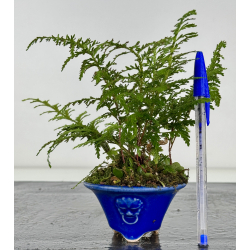KUSAMONO
Kusamono is a word composed of two ideograms meaning:
KUSA: grass and MONO: thing. It is an art in which Japanese masters use small wild plants for these creations. You can use a single plant or several, for which you have to take into account the cultivation requirements of each of the plants you place in the same composition, i.e. if you are going to place a fern that needs a lot of humidity, you cannot combine it with a succulent plant.
They can be exhibited alone or accompanied by kakemonos, figures, etc. and their containers, apart from pots, can be logs, slabs, kuramas... They should generally be exhibited on flat tables, whether they are wooden slabs, bamboo or ceramic trays.
When these wild plants accompany a bonsai or a suiseki in an exhibition, they are called shitakusa, SHITA: low and KUSA: grass. They must be in proportion to the main elements and their containers must be discreet so as not to stand out from them. It is essential that they show the season of the year in which we are, that is to say, if our plant has dry leaves, it cannot be exhibited in spring.
In Laos Garden you can find everything you need to create your kusamono or shitakusa, (wild plants in plastic pots, substrates and containers) as well as delicate compositions already made by us.
The tools, soils and fertilisers you need for your companion plants are practically the same as those you need for the care of your bonsai.
Among the most popular plants for kusamono, we recommend: equisetum, sedges, evergreens, ophiopogon, ledebourias, ferns, imperata and other grasses, sedum, mosses, saxifrage, wild strawberries, dwarf papyrus and many more.

